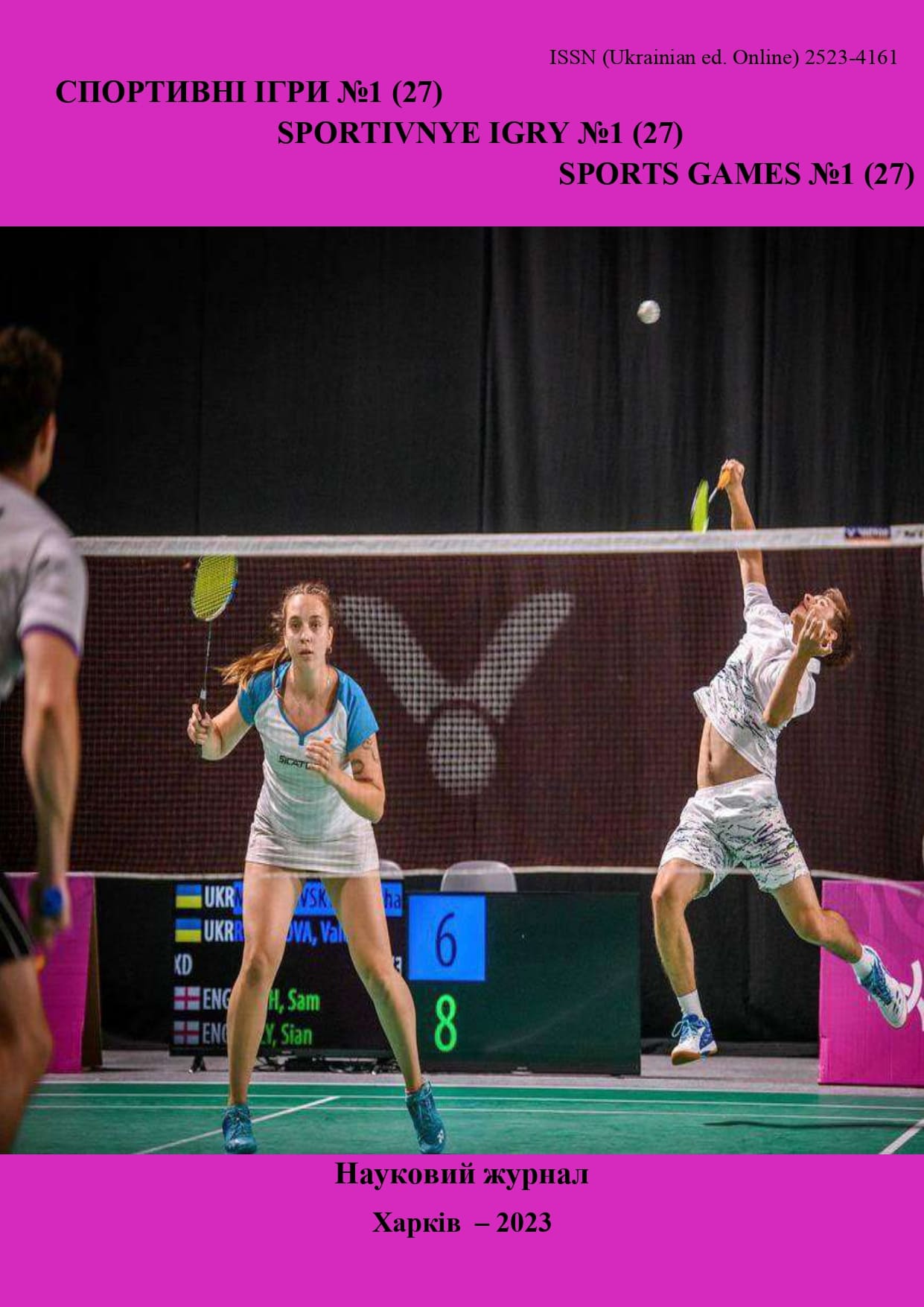Аналіз показників техніко-тактичних взаємодій у баскетболі 3х3
DOI:
https://doi.org/10.15391/si.2023-1.04Ключові слова:
баскетбол 3х3, техніко-тактична дія, техніко-тактична взаємодія, заслін, ігрові показникиАнотація
Командні ігрові види спорту на сьогодні інтенсивно розвиваються, з’являються їх нові різновиди. Досягнення українських команд з баскетболу 3х3 на міжнародному рівні значні, але мають епізодичний характер та тенденцію до зниження рейтингових показників. Однією з сучасних тенденцій розвитку ігрових видів спорту, і баскетболу 3х3 зокрема, є урізноманітнення техніко-тактичних дій та взаємодій, що відбувається зі зростанням спортивної майстерності. Актуальність проблеми дослідження зумовлена відсутністю аналізу змагальної діяльності гравців високої кваліфікації в новому виді спорту з урахуванням кількісних та якісних показників техніко-тактичних дій та взаємодій, що необхідно для розробки програм підготовки гравців. Мета: визначення та порівняння показників техніко-тактичних взаємодій у баскетболістів 3х3 високого класу в різних вікових категоріях. Матеріал та методи. Матеріалом дослідження стали ігрові показники виступів провідних збірних команд світу та України з баскетболу 3х3 на міжнародних змаганнях впродовж 2022 року. В дослідженні використовувалися теоретичний аналіз даних науково-методичної літератури, даних мережі Інтернет з проблеми дослідження, педагогічне спостереження, аналіз змагальної діяльності кваліфікованих баскетболістів 3х3, методи математичної статистики. Результати: аналіз ігрових дій баскетболістів 3х3 провідних команд світу та України на міжнародних змаганнях в різних вікових категоріях виявив стійку тенденцію до збільшення кількісних та якісних показників техніко-тактичних взаємодій зі зростанням спортивної майстерності (у національної збірної команди Сербії кількість результативних атак після техніко-тактичних дій − 46,4 %, після взаємодій – 53,6 %). В збірних командах України така тенденція підтримується, але переважний внесок у результат змагальної діяльності складають індивідуальні дії (у національної збірної команди України – 58 % на 42 % відповідно). В результаті аналізу показників техніко-тактичних взаємодій встановлено значне збільшення як кількості, так і реалізації взаємодій із використанням заслонів в провідних командах світу (від 14 взаємодій при 34 % реалізації у команди Франції U-18, 30 при 40 % Польщі U-23 до 47 взаємодій при 55,3 % реалізації в команді Сербії). В збірних командах України показники кількості цих взаємодій майже не змінні (від 1,0 до 1,5 в середньому за гру) при відносно низькій їх реалізації (від 28,6 % до 37,5 %). Висновки. Отримані кількісні та якісні показники ігрових дій баскетболістів 3х3 провідних команд світу на міжнародних змаганнях в різних вікових категоріях свідчать, що зі зростанням спортивної майстерності найбільший внесок у результат гри приносять результативні техніко-тактичні взаємодії (до 53,6 % Сербія). В збірних командах України переважає індивідуальний стиль гри. Простежується явно виражена тенденція до збільшення техніко-тактичних взаємодій із використанням заслонів, обсяг яких у висококваліфікованих баскетболістів 3х3 Сербії становить 9,5 в середньому за гру, а їх результативність – 55,3 %.
Посилання
Борисова, О.В., & Сушко, Р.О. (2016). Розвиток спортивних ігор в умовах глобалізації спорту: методичні рекомендації. Київ, Науковий світ.
Волков, Д.А., Зарубина, М.С., & Фесенко, Р.П. (2020). Особенности тактических взаимодействий в баскетболе 3x3. Устойчивое развитие: наука и практика, S2 (26), 88–91.
Дмитриев, С.В., & Михалов, Ю.А. (2010). Теория спортивной техники и «семантика движений» – в поисках взаимодействия. Физическое воспитание студентов, 4, 15-25.
Дорошенко, Э.Ю. (2013). Управление технико-тактической деятельностью в командных спортивных играх. Запорожье, ООО ЛИПС ЛТД.
Кайдалов, В.Ф. (2007). Образно-наглядный принцип взаимодействия человеческого фактора и поля его деятельности в командах по игровым видам спорта. Теория и практика физической культуры: тренер: журнал в журнале, 4, 42-44.
Мусієнко, А.В., Несен, О.О., & Цимбалюк, Ж.О. (2021). Результати анкетування спортсменів про баскетбол у форматі 3х3. Спортивні ігри, 1 (23), 21-32.
Несен, О.О., Пащенко, Н.О., & Марченко, К.О. (2018). Показники ігрової діяльності у баскетболі 3х3. Спортивні ігри, 3 (9), 58-65. https://doi.org/10.5281/zenodo.1254042
Соболев, Ю.Л., Сліпуха, В.В., Бацунов, В.П., & Поплавський, Л.Ю. (2015). Баскетбол 3х3. Київ, КНЕУ.
Ставрев, С. (2016). Баскетбол 3 х 3. Методическо ръководство за студенти, преподаватели и студенти. София, УНСС. ISBN 978-954-644-894-1.
Холопов, В., & Безмилов, М. (2020). Особливості змагальної діяльності в баскетболі 3х3. Молодь та олімпійський рух. Київ, 104-106. https://uni-sport.edu.ua/sites/default/files/vseDocumenti/molod_xiii_zbirnyk_.pdf#page=104
Холопов, В., & Безмилов, М. (2020). Особливості реалізації стандартних положень під час розіграшу м’яча з позиції «check-ball» командами високої кваліфікації в баскетболі 3х3. Теорія і методика фізичного виховання і спорту. 4, 43-52.
Шкондя, В.В. (2020). Техніко-тактична підготовка в баскетболі 3х3 шляхом розвитку фізичних якостей. Актуальные научные исследования в современном мире, 1-4 (57), 179-182.
Brasil, D.V.C., Ribeiro, A.N., & Scaglia, A.J. (2019). O basquete 3×3 como facilitador para o desenvolvimento positivo de jovens. E-Balonmano.com: Revista de Ciencias del Deporte, 15, 3, 187-196.
Conte, D., E. Straigis, Е., Clemente, F.M., Gómez, M.A., & Tessitore, А. (2019). Performance profile and game-related statistics of FIBA 3x3 Basketball World Cup 2017. Biology sport, 36 (2), 149-154.
He, Hongliang (2012). A brief analysis of the street basketball. 才智, 1. URL: http://www.cnki.com.cn/Article/CJFDTOTAL-CAIZ201201222.htm
Ji, Bo. (2008). Analysis of Characteristic and Value of Streetball Activity. Journal of Hubei Radio & Television University, 6. URL: http://en.cnki.com.cn/Article_en/CJFDTOTAL-HGDB200806082.htm
Koon, T.K., Wang, C.K.J., & Mallett, C.J. (2012). Discriminating factors between successful and unsuccessful elite youth Olympic Female basketball teams. Int J Perform Anal Sport, 12 (1), 119-131.
Lenart, J. (2019). Košarka 3×3: magistrsko delo. Ljubljana, Univerza v Ljubljani. 100.
Montgomery, P.G., & Maloney, B.D. (2018). 3×3 Basketball: Performance Characteristics and Changes During Elite Tournament Competition. International Journal of Sports Physiology and Performance, 13 (10), 1349–1356. DOI: https://doi.org/10.1123/ijspp.2018-0011
Remmert, H. (2003). Analysis of group-tactical offensive behavior in elite basketball on the basis of a process orientated model. European journal of sport science, 3, 3, 1-12.
Retrieved from URL: http://www.fiba.basketball/3x3
Retrieved from URL: http://www.play.fiba3x3.com
Retrieved from URL: http://www.3x3planet.com













